fuel PONTIAC GRAND AM 1998 Owner's Guide
[x] Cancel search | Manufacturer: PONTIAC, Model Year: 1998, Model line: GRAND AM, Model: PONTIAC GRAND AM 1998Pages: 370, PDF Size: 16.11 MB
Page 289 of 370
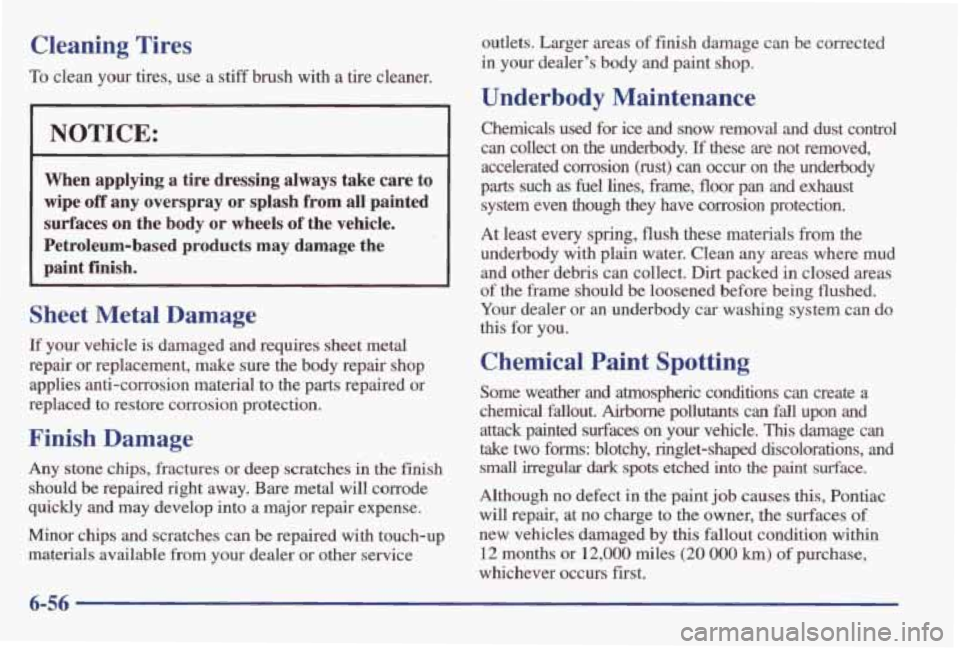
Cleaning Tires
To clean your tires, use a stiff brush with a tire cleaner.
NOTICE:
When applying a tire dressing always take care to
wipe
off any overspray or splash from all painted
surfaces on the body or wheels of the vehicle.
Petroleum-based products may damage the
paint finish.
Sheet Metal Damage
If your vehicle is damaged and requires sheet metal
repair
or replacement, make sure the body repair shop
applies anti-corrosion material to the parts repaired or
replaced to restore corrosion protection.
Finish Damage
Any stone chips, fractures or deep scratches in the finish
should be repaired right away. Bare
metal will corrode
quickly and may develop into a major repair expense.
Minor chips and scratches can be repaired
with touch-up
materials available from your dealer or other service outlets. Larger areas
of finish damage can be corrected
in your dealer’s body and paint shop.
Underbody Maintenance
Chemicals used for ice and snow removal and dust control
can collect on the underbody.
If these are not removed,
accelerated corrosion (rust) can occur on the underbody
parts such
as fuel lines, frame, floor pan and exhaust
system even though they have corrosion protection.
At least every spring, flush these materials from the
underbody with plain water. Clean any areas where mud and other debris can collect.
Dirt packed in closed areas
of the frame should be loosened before being flushed.
Your dealer or
an underbody car washing system can do
this for you.
Chemical Paint Spotting
Some weather and atmospheric conditions can create a
chemical fallout. Airborne pollutants can fall upon and attack painted
surfaces on your vehicle. This damage can
take
two forms: blotchy, ringlet-shaped discolorations, and
small irregular dark spots etched into the paint surface.
Although no defect in the paint job causes this, Pontiac
will repair, at no charge to the owner, the surfaces of
new vehicles damaged by
this fallout condition within
12 months or
12,000 miles (20 000 km) of purchase,
whichever occurs first.
6-56
Page 296 of 370
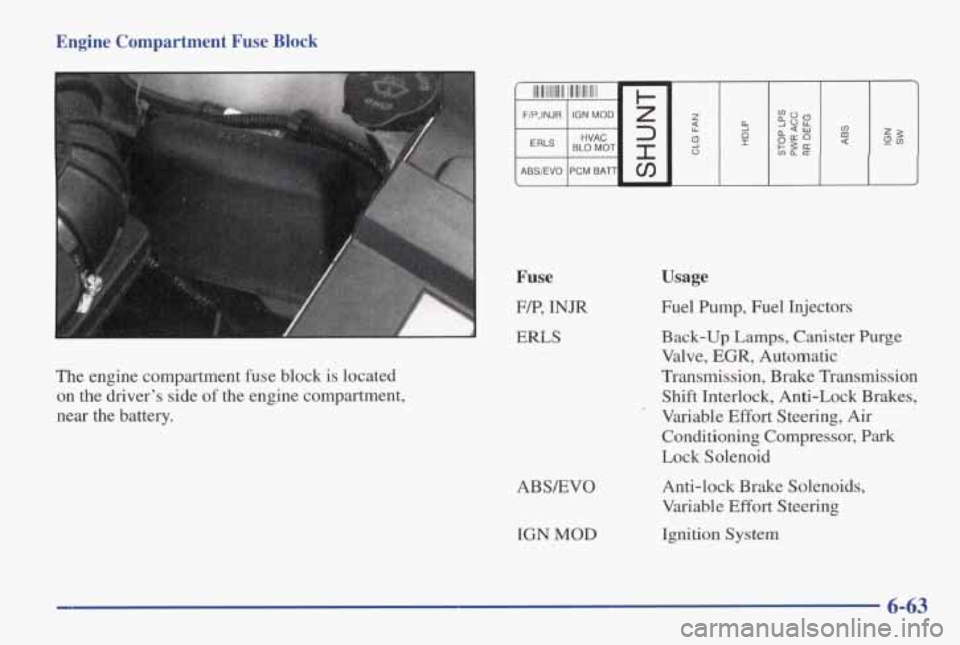
Engine Compartment Fuse Block
Fuse
FA?, INJR
ERLS
The engine compartment fuse block is located
on the driver’s side of the engine compartment,
near the battery.
ABSEVO IGN
MOD
Usage
Fuel Pump, Fuel Injectors
Back-up Lamps, Canister Purge
Valve, EGR, Automatic
Transmission, Brake Transmission
Shift Interlock, Anti-Lock Brakes,
Conditioning Compressor,
Park
Lock Solenoid
* Variable Effort Steering, Air
Anti-lock Brake Solenoids,
Variable
Effort Steering
Ignition
System
6-63
Page 298 of 370
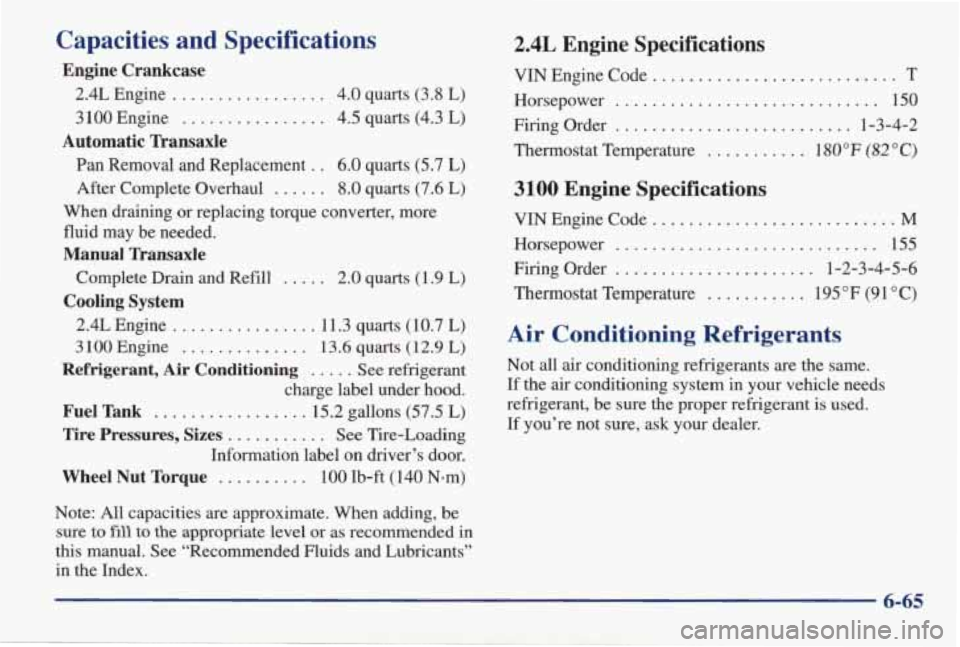
Capacities and Specifications
Engine Crankcase
2.4L Engine ............... 4.0 quarts (3.8 L)
3 100 Engine ................ 4.5 quarts (4.3 L)
Automatic Transaxle
Pan Removal and Replacement . . 6.0 quarts (5.7 L)
After Complete Overhaul ...... 8.0 quarts (7.6 L)
When draining or replacing torque converter, more fluid may be needed.
Manual Transaxle
Cooling System
Complete Drain and Refill . - . - - 2.0 quarts (1.9 L)
2.4L Engine ................ 11.3 quarts (10.7 L)
3100 Engine .............. 13.6 quarts (12.9 L)
Refrigerant, Air Conditioning ..... See refrigerant
charge label under hood.
Fuel Tank ............... 15.2 gallons (57.5 L)
Information label on driver’s door.
Wheel Nut Torque .......... 100 lb-ft (140 Nnm)
Tire Pressures, Sizes ........... See Tire-Loading
Note:
All capacities are approximate. When adding, be
sure to fill to the appropriate level or as recommended in
this manual. See “Recommended Fluids and Lubricants”
in the Index.
2.4L Engine Specifications
VIN Engine Code ........................... T
Firing Order
.......................... 1-3-4-2
Thermostat Temperature
........... 180°F (82°C)
Horsepower ............... .......... 150
3100 Engine Specifications
VIN Engine Code ........................... M
Horsepower ............................. 155
Firingorder
...................... 1-2-3-4-5-6
Thermostat Temperature
......... 195°F (91 “C)
Air Conditioning Refrigerants
Not all air conditioning refrigerants are the same.
If the air conditioning system in your vehicle needs
refrigerant, be sure the proper refrigerant is used.
If you’re not sure, ask your dealer.
Page 305 of 370
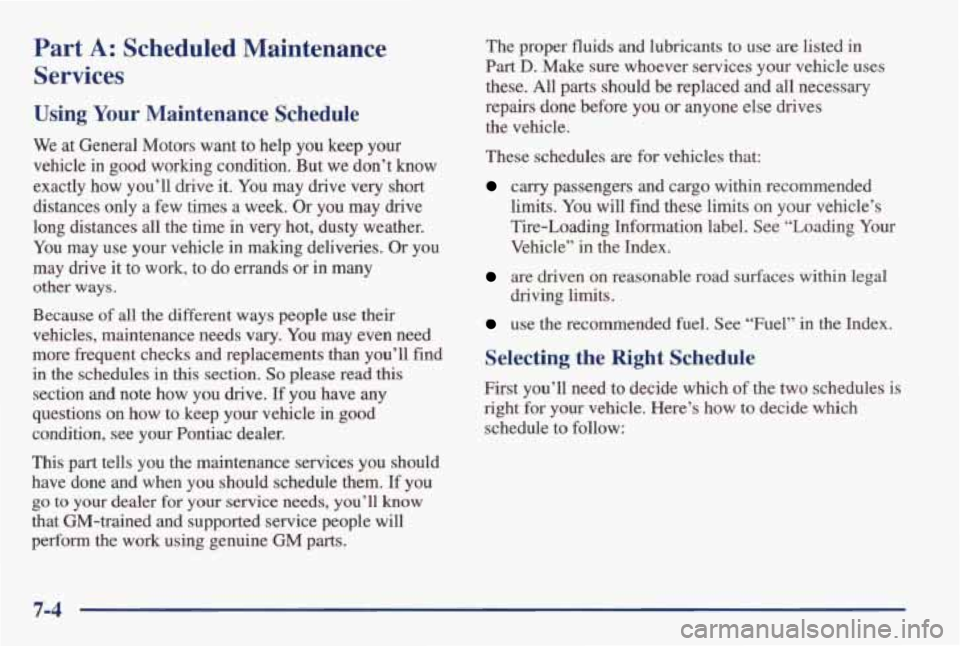
Part A: Scheduled Maintenance
Services
Using Your Maintenance Schedule
We at General Motors want to help you keep your
vehicle in good working condition. But we don’t know
exactly how you’ll drive it. You may
drive very short
distances only a few times a week. Or you may drive
long distances all the time
in very hot, dusty weather.
You may use your vehicle in making deliveries.
Or you
may drive
it to work, to do errands or in many
other ways.
Because
of all the different ways people use their
vehicles, maintenance needs vary. You may even need
more frequent checks and replacements than you’ll find in the schedules
in this section. So please read this
section and note how you drive. If you have any
questions
on how to keep your vehicle in good
condition, see your Pontiac dealer.
This part tells you the maintenance services you should
have done and when
you should schedule them. If you
go to your dealer for your service needs, you’ll know
that GM-trained and supported service people will
perform the work using genuine
GM parts.
The proper fluids and lubricants to use are listed in
Part D. Make sure whoever services your vehicle uses
these.
All parts should be replaced and all necessary
repairs done before you
or anyone else drives
the vehicle.
These schedules are for vehicles that:
carry passengers and cargo within recommended
limits. You will find these limits on your vehicle’s
Tire-Loading Information label. See “Loading Your
Vehicle” in the Index.
are driven on reasonable road surfaces within legal
use the recommended fuel. See “Fuel” in the Index.
driving limits.
Selecting the Right Schedule
First you’ll need to decide which of the
two schedules is
right for your vehicle. Here’s how to decide which
schedule to follow:
7-4
Page 306 of 370
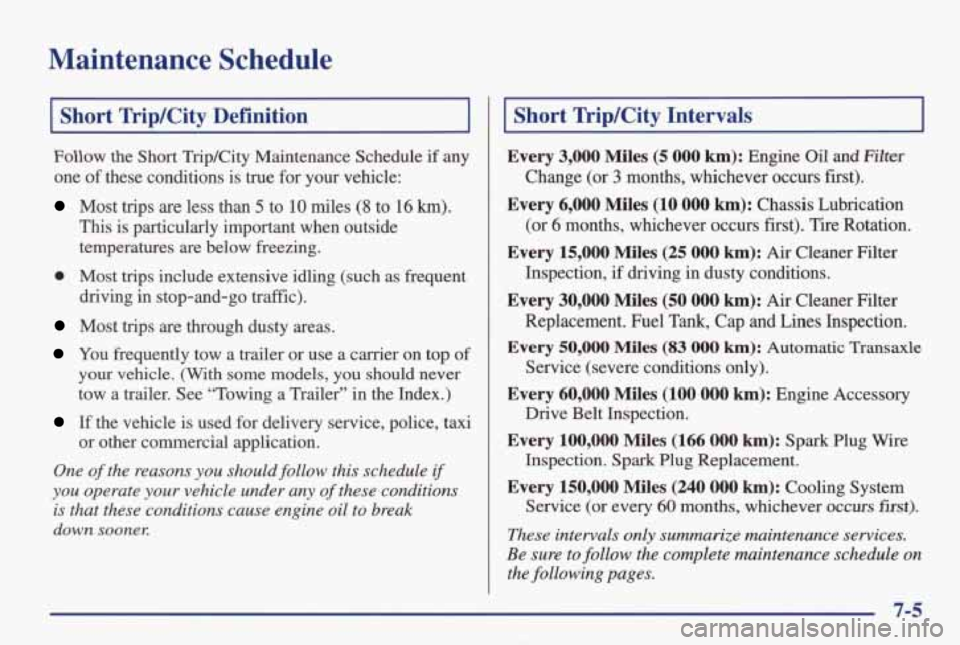
Maintenance Schedule
I Short TripKity Definition I
Follow the Short TripKity Maintenance Schedule if any
one
of these conditions is true for your vehicle:
Most trips are less than 5 to 10 miles (8 to 16 km).
This is particularly important when outside
temperatures are below freezing.
0 Most trips include extensive idling (such as frequent
driving in stop-and-go traffk).
Most trips are through dusty areas.
You frequently tow a trailer or use a carrier on top of
your vehicle. (With some models, you should never
tow a trailer.
See “Towing a Trailer” in the Index.)
If the vehicle is used for delivery service, police, taxi
One of the reasons you should follow this schedule if
you operate your vehicle under any of these conditions
is that these conditions cause engine
oil to break
down sooner.
or other commercial application.
Short TripKity Intervals
Every 3,000 Miles (5 000 km): Engine Oil and Filter
Change (or 3 months, whichever occurs first).
Every 6,000 Miles (10 000 km): Chassis Lubrication
(or
6 months, whichever occurs first). Tire Rotation.
Every 15,000 Miles (25 OOO km): Air Cleaner Filter
Inspection, if driving in dusty conditions.
Every 30,000 Miles (50 000 km): Air Cleaner Filter
Replacement. Fuel Tank, Cap and Lines Inspection.
Every 50,000 Miles (83 0oO km): Automatic Transaxle
Service (severe conditions only).
Every 60,000 Miles (100 000 km): Engine Accessory
Drive Belt Inspection.
Every 100,000 Miles (166 000 km): Spark Plug Wire
Inspection. Spark Plug Replacement.
Every 150,000 Miles (240 000 km): Cooling System
Service (or every
60 months, whichever occurs first).
These intervals only summarize maintenance services.
Be sure to follow the complete maintenance schedule
on
the following pages.
7-5
Page 307 of 370
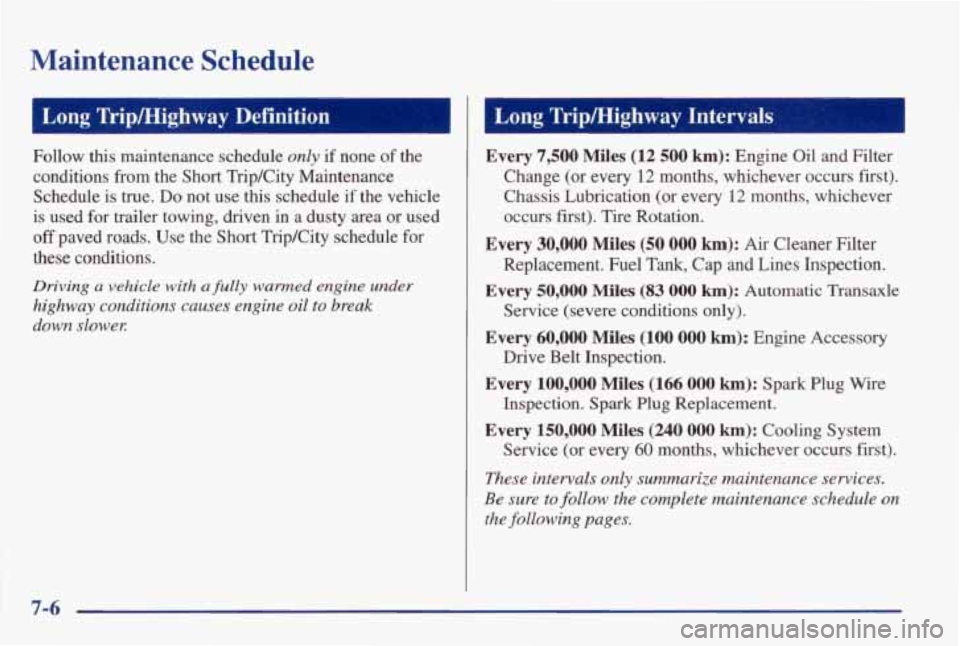
Maintenance Schedule
Long Tripmighway Definition
Follow this maintenance schedule only if none of the
conditions from the Short TripKity Maintenance
Schedule is true.
Do not use this schedule if the vehicle
is used for trailer towing, driven in a dusty area
or used
off paved roads. Use the Short TripKity schedule for
these conditions.
Driving a vehicle with a fully warmed engine under
highway conditions causes engine oil to break
down slower:
Long Tripmighway Intervals
Every 7,500 Miles (12 500 km): Engine Oil and Filter
Change (or every
12 months, whichever occurs first).
Chassis Lubrication (or
every 12 months, whichever
occurs first). Tire Rotation.
Every 30,000 Miles (50 OOO km): Air Cleaner Filter
Replacement. Fuel Tank, Cap and
Lines Inspection.
Every 50,000 Miles (83 OOO km): Automatic Transaxle
Service (severe conditions only).
Every 60,000 Miles (100 000 km): Engine Accessory
Drive Belt Inspection.
Every 100,OOO Miles (166 0oO km): Spark Plug Wire
Inspection. Spark Plug Replacement.
Every 150,000 Miles (240 000 km): Cooling System
Service
(or every 60 months, whichever occurs first).
These intervals only summarize maintenance services.
Be sure to follow the complete maintenance schedule
on
the following pages.
Page 311 of 370
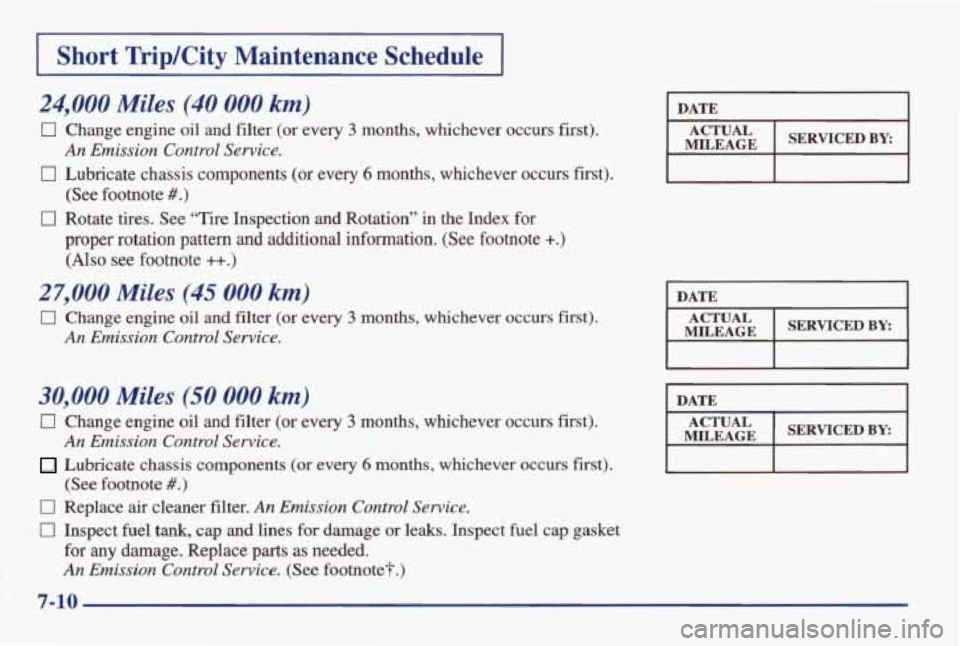
Short TripKity Maintenance Schedule
24,000 Miles (40 000 km)
0 Change engine oil and filter (or every 3 months, whichever occurs first).
0 Lubricate chassis components (or every 6 months, whichever occurs first).
0 Rotate tires. See "Tire Inspection and Rotation" in the Index for
An Emission Control Service.
(See footnote #.)
proper rotation pattern and additional information. (See footnote +.)
(Also see footnote ++.)
27,000 Miles (45 000 km)
0 Change engine oil and filter (or every 3 months, whichever occurs first).
An Emission Control Service.
30,000 Miles (50 000 km)
0 Change engine oil and filter (or every 3 months, whichever occurs first).
An Emission Control Service.
DATE I
1 ACTUAL I SERVICEDBY: I MILEAGE
DATE
1
DATE MILEAGE
ACTUAL SERVICED BY:
Lubricate chassis components (or every 6 months, whichever occurs first). b
0 Replace air cleaner filter. An Emission Control Service.
0 Inspect fuel tank, cap and lines for damage or leaks. Inspect fuel cap gasket
(See footnote
#.)
for any damage. Replace parts as needed.
An Emission Control
Service. (See footnote"f)
7-10
Page 315 of 370
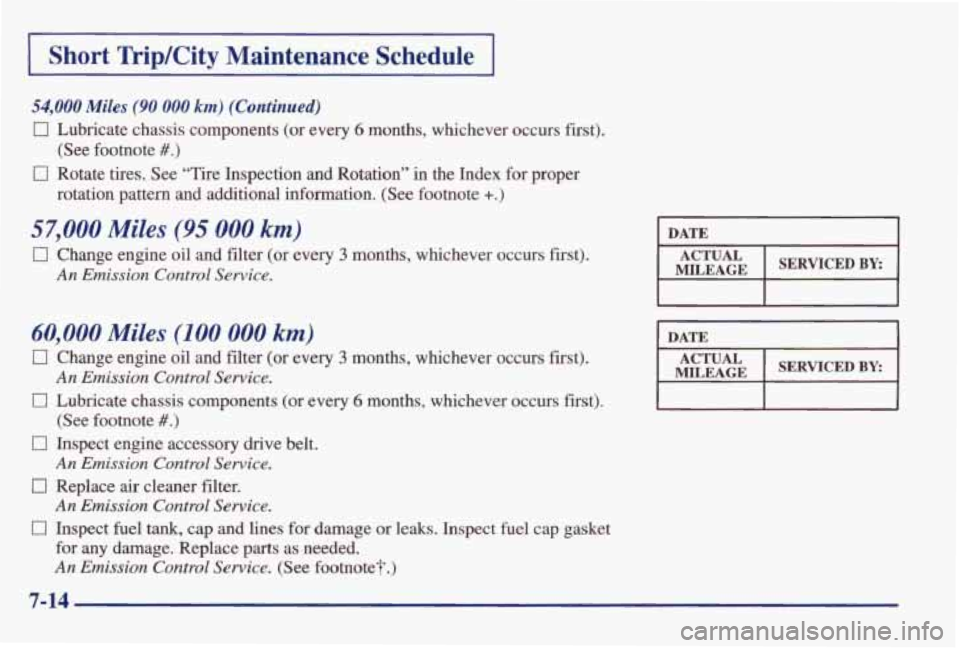
I Short TripKity Maintenance Schedule I
54,000 Miles (90 000 km) (Continued)
0 Lubricate chassis components (or every 6 months, whichever occurs first).
0 Rotate tires. See “Tire Inspection and Rotation” in the Index for proper
(See footnote
#.)
rotation pattern and additional information. (See footnote +.)
57,000 Miles (95 000 km)
0 Change engine
oil and filter (or every 3 months, whichever occurs fist).
An Emission Control Service.
I DATE I
MILEAGE
60,000 Miles (100 000 km)
0 Change engine oil and filter (or every 3 months, whichever occurs first).
0 Lubricate chassis components (or every 6 months, whichever occurs first).
0 Inspect engine accessory drive belt.
0 Replace air cleaner filter.
0 Inspect fuel tank, cap and lines for damage or leaks. Inspect fuel cap gasket
An Emission Control Service.
(See footnote #.)
An Emission Control Service.
An Emission Control Service.
for any damage. Replace parts as needed.
An Emission Control Service. (See footnote’f.)
MILEAGE
Page 319 of 370
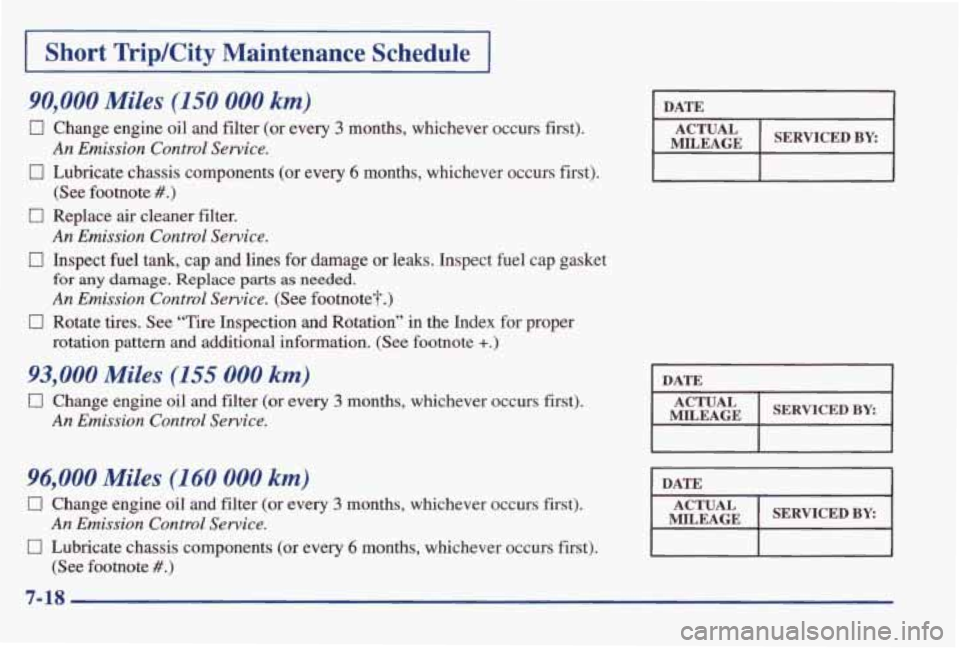
I Short TripKity Maintenance Schedule I
90,000 Miles (I50 000 km)
0 Change engine oil and filter (or every 3 months, whichever occurs first).
0 Lubricate chassis components (or every 6 months, whichever occurs first).
0 Replace air cleaner filter.
0 Inspect fuel tank, cap and lines for damage or leaks. Inspect fuel cap gasket
An Emission Control Service.
(See footnote #.)
An Emission Control Service.
for any damage. Replace parts as needed.
An Emission Control Service. (See footnotes.)
rotation pattern and additional information. (See footnote
+.)
0 Rotate tires. See “Tire Inspection and Rotation” in the Index for proper
93,000 Miles (155 000 km)
0 Change engine oil and filter (or every 3 months, whichever occurs first).
An Emission Control Service.
96,000 Miles (160 000 km)
0 Change engine oil and filter (or every 3 months, whichever occurs first).
0 Lubricate chassis components (or every 6 months, whichever occurs first).
An Emission Control Service.
(See footnote #.)
I DATE 1
DATE 1
7- 18
Page 324 of 370
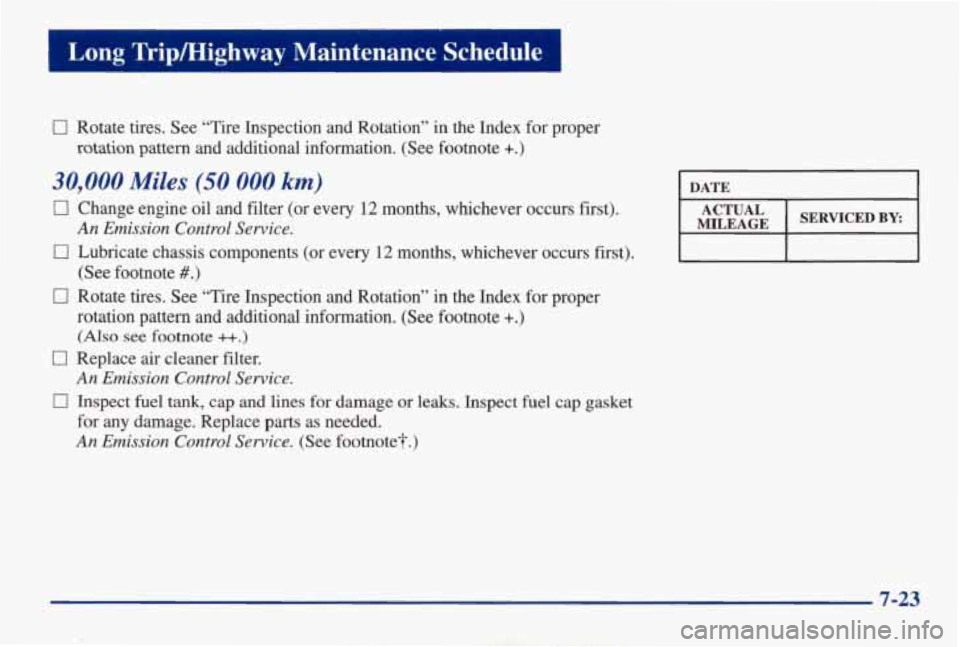
I Long Tripmighway Maintenance Schedule I
0 Rotate tires. See “Tire Inspection and Rotation” in the Index for proper
rotation pattern and additional information. (See footnote
+.)
30,000 Miles (50 000 km)
0 Change engine oil and filter (or every 12 months, whichever occurs first).
0 Lubricate chassis components (or every 12 months, whichever occ\
urs fiist).
17 Rotate tires. See “Tire Inspection and Rotation” in the Index for proper
An Emission Control Service.
(See footnote #.)
rotation pattern and additional information. (See footnote +.)
(Also see footnote ++.)
0 Replace air cleaner filter.
An Emission Control Sewice.
0 Inspect fuel tank, cap and lines for damage or leaks. Inspect fuel cap gasket
for any damage. Replace
parts as needed.
An Emission Control Service. (See footnote?.)
I DATE I
I MILEAGE ACTUAL I SERVICEDBY: I
7-23